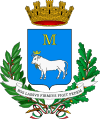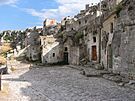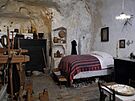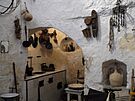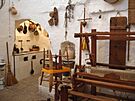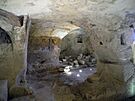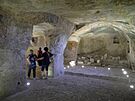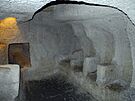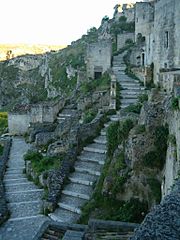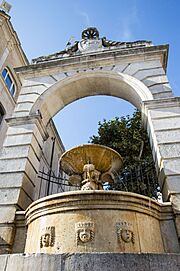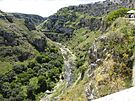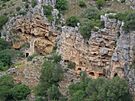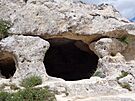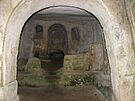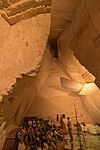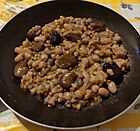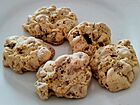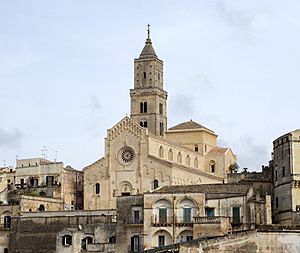Matera facts for kids
Quick facts for kids
Matera
|
|||
|---|---|---|---|
| Comune di Matera | |||
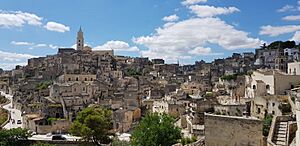
Panorama of Matera
|
|||
|
|||
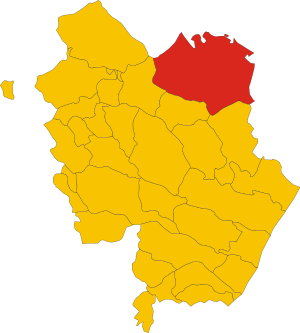
Matera within the Province of Matera
|
|||
| Country | Italy | ||
| Region | Basilicata | ||
| Province | Matera (MT) | ||
| Frazioni | La Martella, Venusio, Picciano A, Picciano B | ||
| Area | |||
| • Total | 387.4 km2 (149.6 sq mi) | ||
| Elevation | 401 m (1,316 ft) | ||
| Population
(January 1, 2018)
|
|||
| • Total | 60,403 | ||
| • Density | 155.919/km2 (403.83/sq mi) | ||
| Demonym(s) | Materani | ||
| Time zone | UTC+1 (CET) | ||
| • Summer (DST) | UTC+2 (CEST) | ||
| Postal code |
75100
|
||
| Dialing code | 0835 | ||
| Patron saint | Madonna della Bruna | ||
| Saint day | July 2 | ||
| UNESCO World Heritage Site | |
|---|---|
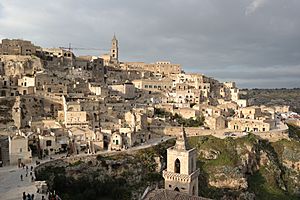
The Sassi of Matera
|
|
| Criteria | Cultural: iii, iv, v |
| Inscription | 1993 (17th Session) |
| Area | 1,016 ha |
| Buffer zone | 4,365 ha |
Matera is a special city in Southern Italy. It is the capital of the Province of Matera in the Basilicata region. Matera is famous for its ancient cave homes, known as the Sassi. People have lived here for a very long time, possibly since the Palaeolithic period, which was about 10,000 BC!
The city sits on the edge of a deep canyon created by the Gravina river. The Sassi are homes dug right into the soft limestone cliffs. The city has a higher part, called Civita, where the main church and government buildings are. Below this, the Sassi areas spread down the cliffs. There are two main Sassi areas: Sasso Barisano and Sasso Caveoso.
The Sassi have many levels, connected by paths, stairs, and courtyards. For a long time, the Sassi were separate from the newer parts of the city. By the 18th century, the Sassi were mostly home to farmers, while richer people lived in the newer areas.
In the early 1900s, the Sassi were seen as unsafe for living. So, between 1952 and the 1970s, the government moved everyone to new homes. Later, in 1986, a new law allowed the Sassi to be restored. This helped bring new life and people back to the area. In 1993, the Sassi and the nearby rock churches became a UNESCO World Heritage Site. This helped bring many tourists to Matera. In 2019, Matera was even named a European Capital of Culture.
Contents
History of Matera
Matera has a very long and interesting history. Before Italy became one country, Matera was ruled by many different groups. These included the Romans, Lombards, Arabs, and Byzantines.
People believe that Matera has been settled since the Stone Age, around 10,000 BC. This makes it one of the oldest places where people have lived continuously in the world.
The Roman general Lucius Caecilius Metellus founded the town in 251 BC. He named it Matheola. Later, in 664 AD, the Lombards took over Matera. In the 7th and 8th centuries, monks started living in the caves nearby.
Matera was sometimes attacked by different groups, including the Arabs. It was also part of the Byzantine Empire for a while. Over the centuries, Matera saw many rulers come and go.
In the 15th century, Matera became part of the Aragonese kingdom. It was given to the Tramontano family. But in 1514, the people of Matera rebelled and killed Count Giovanni Carlo Tramontano. Matera was later the capital of the Basilicata province until 1806. In 1927, it became the capital of the new province of Matera.
Main Sights in Matera
Matera is full of amazing places to see, especially its ancient cave dwellings and churches.
The Sassi (Ancient Town)
The "Sassi di Matera" are what Matera is most famous for. These are homes dug right into the soft rock. They are some of the first human settlements in Italy. Many Sassi homes are small caves. In some parts, a street is actually on top of another group of homes! The Sassi grew on the side of a rocky canyon called "la Gravina."
In the 1950s, the Italian government moved most people out of the Sassi. This was because the homes were very poor and often unsafe. But now, the local government wants to bring the Sassi back to life. They are working with the Italian government and UNESCO to make it a beautiful tourist spot. Today, you can find many businesses, pubs, and hotels in the Sassi. Matera is one of the fastest-growing cities in Southern Italy.
Monasteries and Churches
Matera has many churches, including several "rupestrian churches." These are churches carved directly into the rock. You can find these unique churches in the nearby region of Apulia too.
The Matera Cathedral was built between 1268 and 1270. It has a tall bell tower, 52 meters high. The front of the church has a beautiful rose window. Inside, the church has a main area and two side areas. Most of the decorations are from the 18th century. Recently, a 14th-century painting of the Last Judgement was found inside.
Two other important churches are San Pietro Caveoso and San Pietro Barisano. Both are dedicated to Saint Peter. San Pietro Barisano was recently restored, making it look new again.
Many other churches and monasteries exist, some are simple caves with an altar. Others are large underground cave systems. Monks might have used these for quiet thinking.
Cisterns and Water Collection
Matera is built on a deep canyon, which made it hard to get water. So, the early people of Matera built amazing systems to collect water. They created many cisterns and water channels.
The biggest cistern is called the Palombaro Lungo. It was built in 1832 under Piazza Vittorio Veneto. It's like a huge underground water cathedral, with pillars carved from rock. You can even explore it by boat! This cistern collected rainwater and sent it to the Sassi.
People also had smaller canals and bell-shaped cisterns in their homes. As the city grew, some cisterns were turned into houses. New ways of collecting water were also developed.
Natural Areas
Matera is surrounded by beautiful natural parks.
Murgia National Park
The Murgia National Park was created in 1990. It includes the Gravina di Matera canyon and about 150 rock churches. This area has been home to people since prehistoric times. You can find ancient caves here, like the Grotta dei pipistrelli (cave of the bats). The park's symbol is the lesser kestrel, a type of bird.
San Giuliano Regional Reserve
The San Giuliano Regional Reserve was set up in 2000. It includes Lake San Giuliano, which is a lake made by a dam on the Bradano river.
Timmari
Colle di Timmari is a green plateau about 15 km from Matera. It offers great views of the Bradano valley and Lake San Giuliano. It's a nice place to live, and it has an old church from 1310 called the Sanctuary of San Salvatore. There's also an important archaeological area here.
Other Sights
The Tramontano Castle was started in the early 1500s by Count Gian Carlo Tramontano. But he was killed in a riot, so the castle was never finished. It has three large towers, but it was meant to have twelve. During some repair work, old Roman cisterns and house structures were found under the main square.
The Palazzo dell'Annunziata is a historic building in the main square. It is now home to the Provincial Library.
Culture in Matera
Matera was chosen as the European Capital of Culture for 2019. This means it was a special place for arts and culture in Europe that year.
Cuisine
Matera's food is known as "cucina povera," which means "poor cooking" or peasant food. It uses simple, local ingredients. Since Matera is near the border of Basilicata and Apulia, its food mixes styles from both regions.
Some special foods include "peperoni cruschi," which are sweet, dried peppers. Another famous food is "Pane di Matera," a special bread with a strong flavor and a unique cone shape. This bread has a special status that protects its name. Matera also makes its own wine.
Here are some local dishes:
- Crapiata: A soup made with chickpeas, beans, wheat, and lentils. It's a very old recipe, even from Roman times. People in the Sassi celebrate it every August 1st.
- Orecchiette alla materana: Baked pasta shaped like little ears, with tomatoes, lamb, and cheeses like mozzarella.
- Pasta con i peperoni cruschi: Pasta with fried dried peppers and breadcrumbs.
- Cialedda: A simple dish using stale bread. It can be hot with egg and garlic, or cold with tomatoes and garlic.
- Pignata: Sheep meat cooked with potatoes, onions, and tomatoes in a special clay pot called a "pignata."
- Strazzate: Crunchy cookies made with egg, almonds, and coffee.
Cinema

Because the Sassi look so old and unique, many filmmakers have used Matera as a setting for movies, especially those set in ancient Jerusalem.
Here are some famous movies filmed in Matera:
- The Gospel According to St. Matthew (1964)
- The Passion of the Christ (2004)
- The Nativity Story (2006)
- Ben-Hur (2016)
- No Time to Die (2021) - a James Bond film
Music
Matera has also been featured in music videos. It appears in "Sun Goes Down" (2014) by Robin Schulz and "Spit Out the Bone" (2016) by Metallica.
Religious Traditions
One important tradition in Matera is the Feast of the Madonna della Bruna. It happens every year on July 2nd. A special decorated chariot is part of a religious parade. After the parade, people pull the chariot apart!
There are different stories about how this festival started. One legend says that a woman, who was actually Christ's mother, asked a farmer for a ride to Matera. When they arrived, she told him to tell the bishop she was there. The bishop and people rushed out and found a statue of the Virgin Mary. So, the statue was brought into the city on a grand chariot. Another story says that citizens hid a painting of the Madonna on a small wagon to protect it from attackers. They then destroyed the wagon so the attackers couldn't take the painting.
The name Madonna della Bruna might come from an old word meaning "armor" or "protection." So, it could mean "Madonna of defense." The festival mixes religious parts with fun, wild traditions, like the chariot being pulled apart. This suggests it might have roots in very old traditions from other Mediterranean countries.
The Madonna's statue is kept in the Matera Cathedral. There's also a 13th-century painting of her there.
Notable People from Matera
- Franco Selvaggi (born 1953), a football player who won the World Cup in 1982.
- Luigi De Canio (born 1957), a football manager.
- Cristiana De Filippis (born 1992), a mathematician.
- Egidio Romualdo Duni (1708–1775), a composer.
- Emanuele Gaudiano (born 1986), a horse rider.
- Cosimo Fusco (born 1962), an actor.
- John of Matera (1070–1139), a Benedictine monk and saint.
- Enzo Masiello (born 1969), a Paralympic athlete.
Transportation
Matera has a train station, Matera Centrale, which is the end of the Bari–Matera railway line. The closest airport is Bari Airport. Matera is also connected to major roads and has bus services to other Italian cities.
Sport
- FC Matera, a local football team.
- Olimpia Matera, a basketball team.
Twin Towns – Sister Cities
Matera is connected with these cities around the world:
 Oulu, Finland
Oulu, Finland Petra, Jordan
Petra, Jordan Toms River, United States
Toms River, United States
Images for kids
See also
 In Spanish: Matera para niños
In Spanish: Matera para niños



